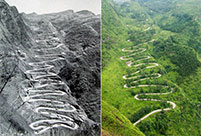

RIO DE JANEIRO, Aug. 3 -- In Brazil's latest power grid map, a new transmission line stretching from the northern state of Para's Belo Monte Dam in the deep Amazon basin to the southern economic centers will become the first "electricity super highway" in both the country and Latin America.
This new 800kV ultra-high-voltage (UHV) direct current (DC) transmission project, with a designed length of over 2,000 kilometers, was launched in May by the State Grid Corporation of China (SGCC) as a model of bilateral production capacity cooperation. Chinese Premier Li Keqiang and Brazilian President Dilma Rousseff witnessed the launch.
Preliminary construction work is still underway. This line is the first UHV transmission project that the SGCC, China's largest power distributor, has won overseas, which marks a milestone in the "going-out" strategy for China's UHV technologies, the company said.
RIGHT CHOICE FOR BRAZIL
Brazil, like China, is a country with a vast territory whose energy consumption centers are far from where the resources are located.
In order to transmit electricity from hydropower stations in the Amazon region in the north to the consumption centers like southern states Sao Paulo and Rio de Janeiro, the Brazilian government in 2013 decided to use the UHV technology, which can transmit a large capacity of electricity over long distances with low loss.
With the first UHV alternating current (AC) project being put into operation in January 2009 and the first UHV DC project in July 2010, China became the first country to have successfully operated a UHV business in another country, said Liu Zhenya, president and CEO of the SGCC.
Chinese technology, which has been tested in operations for years, therefore became the best choice for Brazil.
In February 2014, a consortium formed by State Grid Brazil Holding and two Brazilian companies won the first bid to build and operate a 2084-km transmission line connecting the Belo Monte hydropower plant to the southern state of Minas Gerais near Sao Paulo and converter stations. Last month, State Grid Brazil Holding won the second bid to build a 2,250-km transmission linking the Belo Monte power plant to the town of Nova Iguacu near Rio de Janeiro.
The constructions are expected to be finished in four years and State Grid Brazil will maintain the concession for 30 years.
Brazil's hydropower potential ranks third in the world, following Russia and China. Almost 80 percent of the energy consumed in the country originates from hydroplants.
The Belo Monte hydroelectric dam, expected to be completed by January 2019 with a designed capacity of 11,233 megawatts, will be the third largest in the world behind the Three Gorges Dam in China and the Brazilian-Paraguayan Itaipu Dam. The dam and UHV transmission projects, if completed, will greatly power the development of energy-hungry southern areas.
China's UHV technology brings a huge opportunity to the development of Brazil's electric industry, said Jose da Costa Carvalho Neto, chief executive of Electrobras, Brazil's listed state-controlled electricity operator.
Electrobras has the only lab in the southern hemisphere to test the UHV AC and DC equipment. Building UHV lines will not only secure Brazil's leading position in the hemisphere, but also help Brazil take the lead in electrical technologies in the world, Costa said.
WIN-WIN PROJECTS
Introducing UHV DC technology from China to Brazil will bring revolutionary changes to north-to-south electricity transmission projects. The two transmission projects, with a total investment of 15 billion reais (4.7 billion U.S. dollars), are expected to create around 34,800 jobs in Brazil, according to estimates of the Brazilian government.
"Those projects will yield win-win results," said Zhang Jianping, an expert at the Academy of Macroeconomic Research of China's National Development and Reform Commission.
In addition, the projects will create a huge demand for electricity equipment and steel and push Brazil to update its power infrastructure.
Such projects will be very important for Brazil, which faces an economic slowdown to battle economic recession, Zhang said.
To China, those two transmission lines brought breakthroughs to the overseas development of its UHV technologies. Given the weak export growth, those projects will serve as a window for the world to see China's advanced technology and production capability. Those can be new growth points in foreign trade for China, Zhang said.
China and Brazil are two important developing countries in the world. SGCC's Belo Monte UHV transmission projects will become a model of South-South cooperation and earn an overseas reputation.
"In addition to the high-speed rails and nuclear power plants, the UHV transmission technologies can be the third flagship product of China's advanced technology and equipment," Zhang said.
The SGCC entered the Brazilian market in 2010 and is now the fourth largest electricity transmission system operator in the country. In addition, it also operates power transmission grids in the Philippines, Brazil, Portugal, Australia, Italy and Hong Kong, with total overseas investments of 9.8 billion dollars.
 Mums stage breastfeeding flash mob
Mums stage breastfeeding flash mob Moscow “spider-man” climbs Chinese skyscraper
Moscow “spider-man” climbs Chinese skyscraper No cleavage allowed at China’s largest gaming expo this year
No cleavage allowed at China’s largest gaming expo this year Photo story: A model’s breast implant surgery
Photo story: A model’s breast implant surgery Student proposes during graduation ceremony
Student proposes during graduation ceremony Kiss contest held in Nanning, SW China
Kiss contest held in Nanning, SW China Bikini beauties lifeguards in river rafting place
Bikini beauties lifeguards in river rafting place Yunnan-Myanmar Road: The past and present
Yunnan-Myanmar Road: The past and present An unbreakable army
An unbreakable army Sharing with strangers
Sharing with strangers US cyber ‘retaliation’ shows hypocrisy
US cyber ‘retaliation’ shows hypocrisy Markets fall again despite govt support
Markets fall again despite govt support China’s police dogs train to sniff out crime
China’s police dogs train to sniff out crimeDay|Week